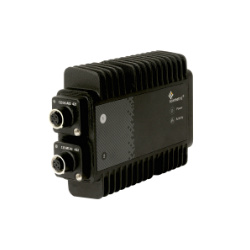Contributed by: David Mannila

Machines and processes are increasingly being connected to share data as part of the Industrial Internet of Things (IIoT) and Industry 4.0 applications. This data flow can quickly become a flood that creates bandwidth and latency issues for a centralized network architecture.
The answer is to create a distributed architecture by deploying intelligence at the network edge. Individual devices, or modules, with varying degrees of data collection and processing capability are installed as close as possible to the network’s various data sources.
Design Considerations
Let’s run through the design considerations that should be reviewed to ensure these edge modules have the physical characteristics and the functionality to reliably and cost-effectively perform as needed.
1) Consider the size and enclosure
In this case, bigger is not better. The smaller the module, the more versatile it can be, to fit where you need it to. It should be a self-contained unit with its own sealed enclosure. That way, in can be externally mounted and easily accessed, in close proximity to the source of the data being collected.
2) Evaluate the operating environment
Ambient temperature and humidity extremes or risk of physical damage have to be considered with the choice of material for, and the design of, the enclosure.
3) Identify what you need the module to do
With today’s technology, more computing horsepower won’t impact the module size or its environmental requirements. It can, however, make a huge difference in cost.
If the edge module is only expected to take static measurements at intervals measured in seconds or minutes, a low cost, off-the-shelf processor may be sufficient. On the other hand, if the module must sample continuously at a very high rate – at thousands or even millions of times per second – it can drive the cost of the system much higher.
4) What type of data will be received?
This is an analog versus digital question. The answer will dictate the type of data interface and signal conditioning that is required. The module must be designed to handle the maximum possible magnitude of the signal and have sufficient resolution to detect the smallest desired variation in the signal being measured.
5) What do you want to do with the data?
Is the requirement simply to collect and pass it along the network, or to have autonomous decision-making taking place within the module based on the data received?
The answer will not only dictate the horsepower (and resulting cost) required of the hardware, it will also influence the choice of software with which to manage the module.
6) What are your plans for the device output?
If the module is performing some level of signal processing and analysis on the data it receives, where will that output go? Will it simply be passed along for storage and future analytics, or will it serve as an instruction that is sent back to the data’s point of origin—the specific machine or process? The answer will again impact the choice of hardware and software.
7) How do you want to access the module?
What kind of accessibility do you want for device configuration and management? You may want an entirely wireless connection, or the ability for remote management from anywhere in the world. Or it may be enough to just plug in a USB cable for access.
These answers to these questions will help inform your decisions as you consider your options for deploying intelligence at the network edge.
Looking to add intelligence and edge analytics to your network?
The Sciemetric EDGE platform offers a compact, modular design the delivers in-depth insight into the performance, reliability and repeatability of a broad range of applications. Systems are remotely configurable for centralized management of your operations. Contact us to discuss how this platform could be used to improve your industrial operations.


